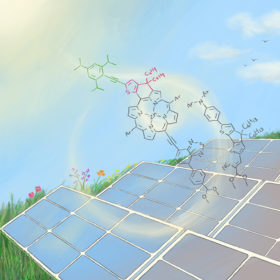
The improved performance was achieved by using a methylene bridged material, the molecular dye DfZnP-iPr.
Researchers at the Institute for Integrated Cell-Material Sciences at Japan’s Kyoto University claim to have developed a dye-sensitized solar cell with 10.7% efficiency.
In their study, Renaissance of Fused Porphyrins: Substituted Methylene-Bridged Thiophene-Fused Strategy for High-Performance Dye-Sensitized Solar Cells – published in the Journal of the American Chemical Society – the scientists claim the device is the most efficient technology available for dye-sensitized cells with fused porphyrin sensitizers.
To achieve the improved performance the researchers used a methylene bridged material – a new molecular dye called DfZnP-iPr – by fusing it to the porphyrin core.
According to the paper’s authors, the fusion of a substituted methylene-bridged small aromatic ring to a porphyrin core enabled them to eliminate problems typical of solar cells based on aromatic-fused porphyrin sensitizers. Such devices usually exhibit a high aggregation tendency and a short exciton lifespan.
The researchers said the fusion overcomes such downsides, particularly by suppressing aggregation.
“Our strategy will reboot the exploration of aromatic-fused porphyrin sensitizers for high-performance DSSCs [dye-sensitized solar cells],” the research team stated.
The scientists claim aromatic ring fusion to a porphyrin core is becoming an attractive option for dye-sensitized cells because of its extended π-conjugation and resultant red-shifted absorption.
Lắp đặt điện mặt trời Khải Minh Tech
https://ift.tt/2X7bF6x
0906633505
info.khaiminhtech@gmail.com
80/39 Trần Quang Diệu, Phường 14, Quận 3
Lắp đặt điện mặt trời Khải Minh Tech
https://ift.tt/2ZH4TRU
Không có nhận xét nào:
Đăng nhận xét